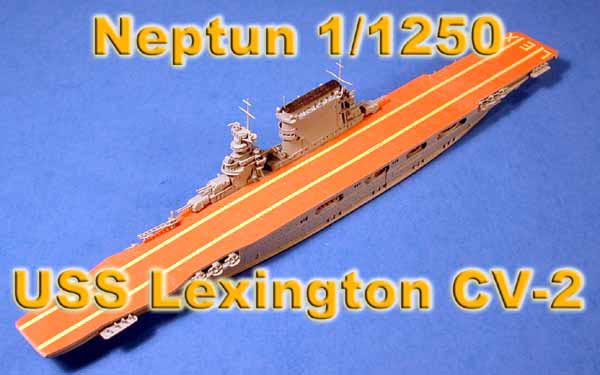

| Laid down as one of the Constellation-class
battle cruisers, Lexington and her sister Saratoga were converted to aircraft
carriers as part of the Washington Naval Treaty in 1921. Large and fast,
the two carriers became the test bed and proving ground for US Naval Aviation
in the 20’s the 30’s.
On December 5, 1941, Lexington departed Pearl Harbor,
carrying planes to reinforce the garrison on Midway Island. Two days later,
the Lady Lex was still at sea when the Japanese struck Pearl Harbor. She
joined up with Enterprise to search for the enemy task force, which they
fortunately did not find. Joining with “Sister Sara”, the Lexington was
part of the abortive attempt to relieve Wake Island in late December.
After spending time on patrols protecting Oahu,
in February the Lexington was en route to raid the Japanese base at Rabaul
when her Task Group was attacked by Japanese planes. During the attack
– in which seventeen attackers were shot down – Lt Butch O’Hare won the
Medal of Honor for splashing five planes himself.
In March, she teamed with the carrier Yorktown to
raid Lae and Salamaua, then returned to Hawaii, where her 8 inch guns were
removed and replaced with 1.1 inch anti-aircraft guns.
By May, Lex and Yorktown were back together, operating
to blunt Japanese attempts to move on Port Moresby and Australia. On May
7th, Lexington’s planes found and sunk the Japanese light carrier Shoho,
prompting the famous “Scratch one flat top” radio call. However, bigger
game was afoot. The Japanese fleet carriers Shokaku and Zuikaku – veterans
of the Pearl Harbor raid - were still out there waiting to be found and
looking for the American task force.
On May 8th, the two sides found each other. While
Shokaku was heavily damaged by American planes and Zuikaku had her air
group chewed up, the Japanese were able to penetrate the American CAP and
anti-aircraft fire around 11 in the morning, scoring hits on both US carriers.
During the attack, Lexington was struck by two torpedoes
and three bombs. The gallant Lady Lex shook off the blows and was able
to steam at 25 knots and recover her air group while her damage control
teams beat back the fires. It looked like the Lexington was going to survive
until she was rocked by a massive explosion early in the afternoon. The
bomb damage had caused gas vapor leaks below decks. The vapors reached
a generator that not been shut off, igniting the fumes and dooming the
ship.
Ablaze and wracked by explosions, Lexington was
abandoned at 5 o’clock in the afternoon. Drifting towards the Japanese
and refusing to sink, she was finally dispatched by torpedoes from the
destroyer Phelps, sinking at around 8pm on May 8th.
|
|||||||||||||||||||||
|
This recent release by Neptun is one of the most detailed ships I have seen to date. The painting is top notch and the detail rivals that found in larger scale kits. The ship comes completely assembled and professionally painted in overall gray and a mahogany deck with yellow stripes. Even the direction lights are hand painted green and red.
|
|||||||||||||||||||||
Conclusions:

A nice ship with a surprising amount of detail of detail for 1/1250 scale. This is kit #1316 USS Lexington 1940 for 114.25. Special thanks to Morning Sunshine Models for the sample. They carry the entire Neptun line of ships. |
|||||||||||||||||||||
